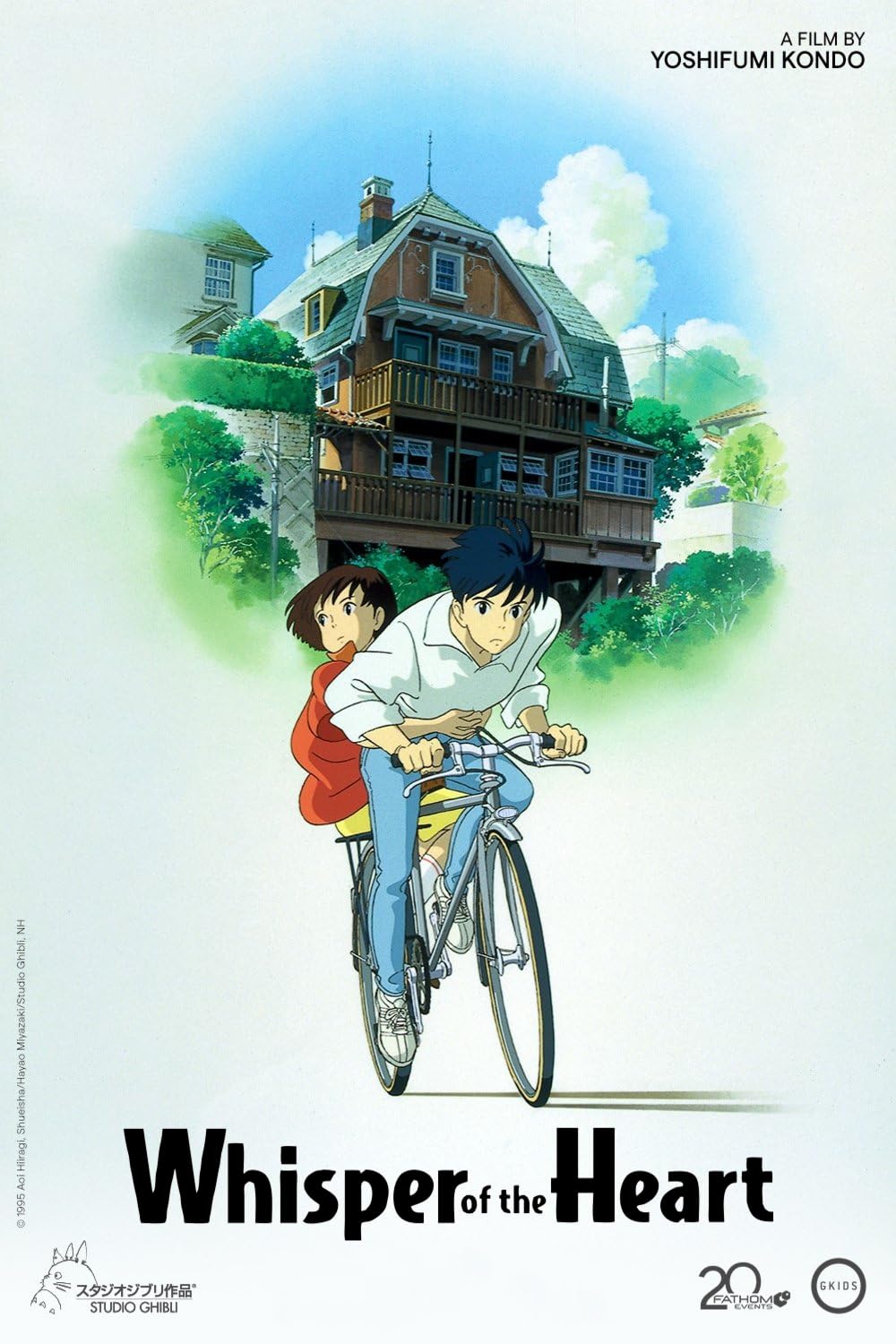
"Whispers of the Heart" (Japanese: "Mimi wo Sumaseba") is a beloved animated film that holds a special place within the realm of Japanese cinema. Released in 1995 and produced by Studio Ghibli, the film is celebrated for its heartfelt storytelling, charming characters, and beautiful animation. Unlike many of the studio’s more fantastical works, this film offers a tender exploration of everyday life, dreams, and self-discovery. Its universal themes and relatable characters have resonated with audiences worldwide, making it a timeless classic in the world of animated films. As a work that captures the innocence of youth and the pursuit of one’s passions, "Whispers of the Heart" continues to inspire viewers and filmmakers alike.
An Introduction to "Whispers of the Heart": A Classic Japanese Animated Film
"Whispers of the Heart" is a coming-of-age story that follows a young girl named Shizuku Tsukishima as she navigates the challenges of adolescence, aspirations, and love. Set against the backdrop of a bustling Tokyo neighborhood, the film delicately portrays the everyday experiences of high school students. Its narrative emphasizes the importance of listening to one’s inner voice and believing in the possibility of dreams coming true. The film is distinguished by its warm, realistic tone and focus on character development, making it a standout example of Japanese animation that appeals to both young audiences and adults. As a product of Studio Ghibli, it reflects the studio’s commitment to storytelling that is both visually stunning and emotionally resonant.
The Creative Minds Behind "Whispers of the Heart" and Their Vision
The film was directed by Yoshifumi Kondō, a talented filmmaker known for his gentle storytelling and beautiful visual sensibilities. It was written by Hayao Miyazaki, who adapted the screenplay from the manga "Mimi wo Sumaseba" by Aoi Hiiragi. Miyazaki’s involvement ensured that the film retained a poetic and heartfelt quality, emphasizing themes of self-discovery and artistic pursuit. The collaboration between Kondō and Miyazaki aimed to create a film that celebrated the ordinary moments of life while inspiring viewers to chase their dreams. The creative vision was to craft an intimate, character-driven story that highlighted the beauty of everyday experiences and the importance of following one’s passions, blending realism with subtle fantasy elements.
Exploring the Main Characters and Their Development in the Film
At the heart of "Whispers of the Heart" is Shizuku Tsukishima, a curious and earnest girl with a love for reading and writing. Throughout the film, she grapples with self-doubt and the uncertainty of her future, gradually discovering her own voice and artistic talent. Her journey is complemented by Seiji Amasawa, a passionate young boy aspiring to become a violin maker. Seiji’s own ambitions challenge and inspire Shizuku, fostering a mutual growth that underscores the film’s themes of mentorship and encouragement. Supporting characters, such as her family and friends, add depth and realism to the narrative, illustrating the importance of community and support in personal development. The characters’ evolution from uncertainty to confidence is portrayed with sensitivity, making their stories both relatable and inspiring.
The Artistic Style and Visual Aesthetics of "Whispers of the Heart"
The visual style of "Whispers of the Heart" is characterized by its detailed and warm animation, capturing the charm of everyday life in Tokyo. The backgrounds are meticulously crafted, showcasing lush cityscapes, cozy interiors, and vibrant seasons that evoke a sense of time and place. The character designs are soft and expressive, emphasizing their emotions and personalities. Studio Ghibli’s signature hand-drawn animation techniques lend a tactile quality to the film, creating an immersive experience. The use of color is subtle yet effective, often reflecting the mood of the scenes—warm tones during moments of hope and introspection, cooler hues during moments of doubt. Overall, the aesthetic approach enhances the storytelling, making the film visually soothing and emotionally engaging.
Themes of Dreams, Romance, and Self-Discovery in the Movie
"Whispers of the Heart" explores universal themes that resonate across cultures and generations. Dreams serve as a central motif, inspiring characters like Shizuku and Seiji to pursue their passions despite obstacles. The film delicately balances romance with personal growth, illustrating how love and admiration can motivate individuals to strive for their best selves. Self-discovery is depicted as a gradual process, often intertwined with creative expression and supportive relationships. The narrative encourages viewers to listen closely to their inner voices and to believe in the possibility of achieving their aspirations. It also emphasizes that the journey of self-discovery is as important as the destination, fostering a message of hope, perseverance, and the importance of staying true to oneself.
The Soundtrack and Musical Elements That Enhance the Story
Music plays a vital role in "Whispers of the Heart," complementing its emotional depth and narrative flow. The film’s soundtrack features gentle, melodic tunes that evoke nostalgia and tenderness, enhancing key moments of introspection and romance. Notably, the song "Country Roads," performed by the character Seiji, underscores themes of longing and hope, bridging the story’s emotional landscape. The musical score incorporates both classical and contemporary elements, reflecting the characters’ artistic pursuits and personal aspirations. The soundtrack’s understated yet evocative nature allows viewers to immerse themselves fully in the story, amplifying the film’s heartfelt messages. The music not only enhances the mood but also serves as a narrative device that connects the characters’ emotions and experiences.
Cultural Context and Influence of "Whispers of the Heart" in Japan
Released during a period of rapid modernization in Japan, "Whispers of the Heart" offers a nostalgic look at traditional values and the importance of personal authenticity amid societal change. The film’s portrayal of Tokyo’s neighborhoods and the emphasis on artistic pursuits reflect Japan’s rich cultural heritage and appreciation for craftsmanship. Its themes of self-discovery and perseverance resonate with Japanese audiences, reinforcing cultural ideals of diligence and humility. The film also influenced the broader landscape of Japanese animation by demonstrating that animated films could tell mature, nuanced stories grounded in reality. Its success helped pave the way for future films that blend everyday life with artistic expression, contributing to Japan’s reputation for producing high-quality, emotionally impactful animation.
Critical Reception and Audience Reactions Over the Years
Upon its release, "Whispers of the Heart" received widespread acclaim from critics and audiences alike. Critics praised its delicate storytelling, relatable characters, and beautiful animation, often highlighting its departure from more fantastical Ghibli films. Fans appreciated its heartfelt exploration of youth and creativity, making it a favorite among viewers of all ages. Over the years, the film has maintained a strong reputation, often cited as one of Studio Ghibli’s underrated gems. Its gentle tone and universal themes have led to enduring popularity, with many viewers revisiting it for inspiration and comfort. The film’s reputation has grown through word-of-mouth and its inclusion in various retrospectives of Japanese animation, cementing its status as a classic.
Comparing "Whispers of the Heart" to Other Studio Ghibli Films
While many Studio Ghibli films are renowned for their fantastical worlds—such as "My Neighbor Totoro" or "Spirited Away"—"Whispers of the Heart" stands out for its grounded, slice-of-life approach. Unlike films that emphasize magic or supernatural elements, this movie centers on real-life experiences, making it more relatable to everyday audiences. Its focus on personal growth, romance, and artistic pursuits aligns with Miyazaki’s broader themes but in a more intimate setting. The artistic style, while consistent with Ghibli’s high standards, is slightly softer and more subdued, reflecting its realistic tone. Despite these differences, the film shares the studio’s signature craftsmanship, emotional depth, and dedication to storytelling that appeals to a wide demographic. It complements Ghibli’s diverse portfolio by showcasing the versatility of animation as a medium for heartfelt, human stories.
Legacy and Impact of "Whispers of the Heart" on Anime Cinema
"Whispers of the Heart" has left a lasting mark on both anime cinema and popular culture. Its success demonstrated that animated films could address mature themes with subtlety and emotional depth, inspiring future filmmakers to pursue more nuanced storytelling. The film’s portrayal of relatable characters and realistic settings has influenced countless creators in Japan and beyond. Additionally, it has fostered appreciation for the potential of animation as a medium for introspection and artistic expression. The film’s enduring popularity has led to adaptations, such as the 1995 live-action film and its influence on subsequent works that explore themes of youth and creativity. Ultimately, "Whispers of the Heart" remains a testament to the power of animation to tell meaningful stories, reinforcing Studio Ghibli’s reputation for crafting timeless, emotionally resonant films.
"Whispers of the Heart" continues to enchant audiences with its gentle storytelling, beautiful visuals, and heartfelt themes. As a quintessential example of Japanese animated cinema, it exemplifies how animation can transcend entertainment to explore deeper human experiences. Its legacy endures not only through its influence on the industry but also through the lasting impressions it leaves on viewers worldwide. The film’s celebration of dreams, romance, and self-discovery ensures its place as a cherished classic that will inspire generations to come.




